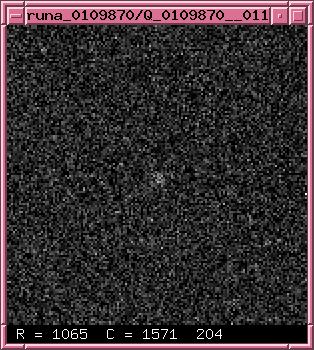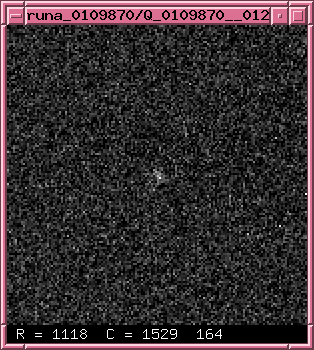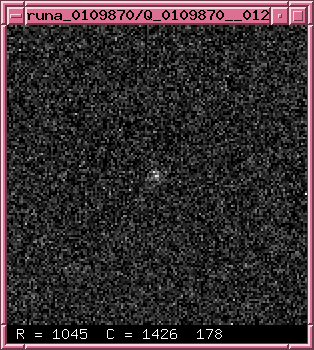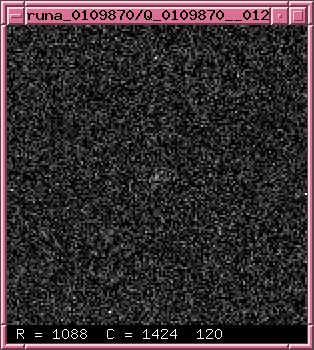




I started investigating methods to find transient sources in the output of the pipeline. One can divide such methods into two main groups, based on the starting point:
However, objects which appear in a SINGLE IMAGE will not be in this dataset.
Moreover, the ensemble is created for one "chunk" of images at a time (each chunk is up to 360 consecutive images). If an object appears near the end of chunk N, and into the beginning of chunk N+1, those appearances will not be connected by this method (without extra work afterward).
One can read information from one image's detections at a time, but one will then have to do extra work to figure out if a particular object was detected only once, or twice, or three times ...
This note discusses a method which falls in the first category: it is based on ensemble output. I have not (yet) created a method of the second type.
The following are the conditions an object must meet in order to be classified as a "transient" by my software. Most of the following tests include parameters than may easily be changed; running the tests on the pipeline output takes only a minute or so for a full night's measurements of one chip, so one can quickly change a test and see the results.
First, a quick list of tests; then, we'll explain each one.
Okay, let's go over each test in some detail.
min_det ≤ number of detections ≤ max_det
ensemble mag ≤ limiting_mag + mag_extra
An example will make the following discussion clear. Suppose that a faint object appears in some of a set of 10 images:
image index 1 2 3 4 5 6 7 8 9 10
---------------------------------------
object appears no no yes yes no yes no yes no no
In this example, the object appears in 4 images, spread out over a span of 6 images (starting in 3, ending in 8).
We can define this idea as follows:
let first_det = image index of first detection
let last_det = image index of last detection
this_window = (last_det - first_det) + 1
So in this case, this_window = 6.
We then define
max_window = number_of_detections + window_extra
and then set a condition for transients:
this_window ≤ max_window
In this case, the object is detected 4 times. If we set window_extra = 0, that means that all of the detections must be consecutive. That would cause this object to fail the test.
On the other hand, if we set window_extra = 3, we allow the object to be undetected in up to 3 images interspersed with the detections. In this case, that would yield the condition
(this_window = 6) ≤ (max_window = 4 + 3 = 7)
and so this candidate would pass the test and be counted as a transient.
closest_neightbor ≥ min_permitted_distance
distance from border ≥ border_width
Since each image has an active, on-sky area which is roughly 1140-by-2008 pixels, this small region around the edge is only a tiny fraction of the area of each image. With the current values, roughly 1/36 = 0.027 of each image is discarded.
I ran the pipeline on all images taken with chip 0, on the night of 2016 Apr 11 = 20160411. The images cover the following range:
TMPM 0108830 starting JD 2457489.999
TMPM 0110880 ending JD 2457490.247
Thus, roughly 0.25 of a day, or about 6 hours. Some chunks of data (each chunk is about 3 minutes) have few or no good images, so the total "good" observational duration is somewhat less.
Using the tests described above, with the conditions
I found a total of one (1) candidate. Below is some information about this candidate, which is computed automatically by the transient-finding routine.
chunk 0109870 RA = 192.45738 Dec = -16.38340
mag = 15.924
ndet = 3
first appears in image index 120
last appears in image index 122
This appears to be coincident with USNO-B1.0 0736-0258873, a star with mag B = 16.7, R = 15.5. So, clearly, a non-transient source. The agreement between the pipeline's measurement of magnitude and that suggested by USNO B1.0 is nice.
Below are images of the object, starting in image 119 (one frame BEFORE the first detection) and ending in image 123 (one frame AFTER the last detection).





As you can see, this is a real star, which is present both before the first detection by the pipeline, and after the last detection by the pipeline. It appears to me that either cosmic rays, a hot pixel, or three consecutive noise peaks caused the object to become just bright enough to exceed the threshold for detection on three consecutive images.
I tried changing the parameter min_det from 3 to 2. The number of transient candidates increased from 1 to 112! What happened?
It turned out that in one of the chunks during this run, chunk 0109290, contains just two good images. That means that every ordinary star detected in that chunk has exactly 2 detections. Hence, all the ordinary stars were flagged as "transients" in that chunk.
Whoops.